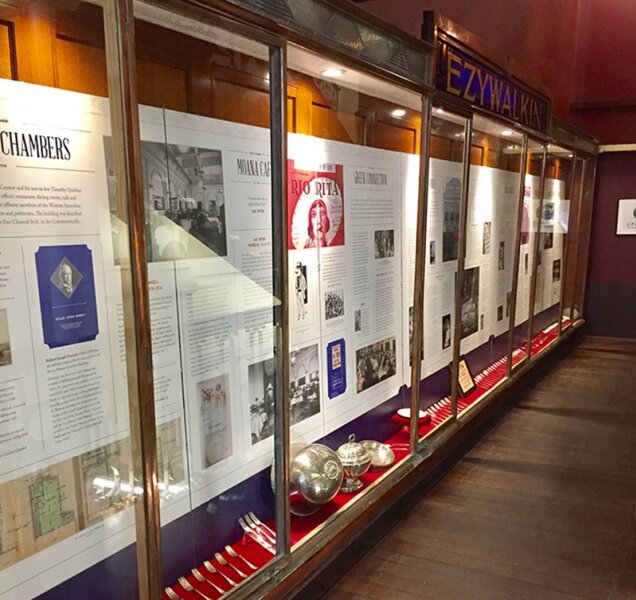
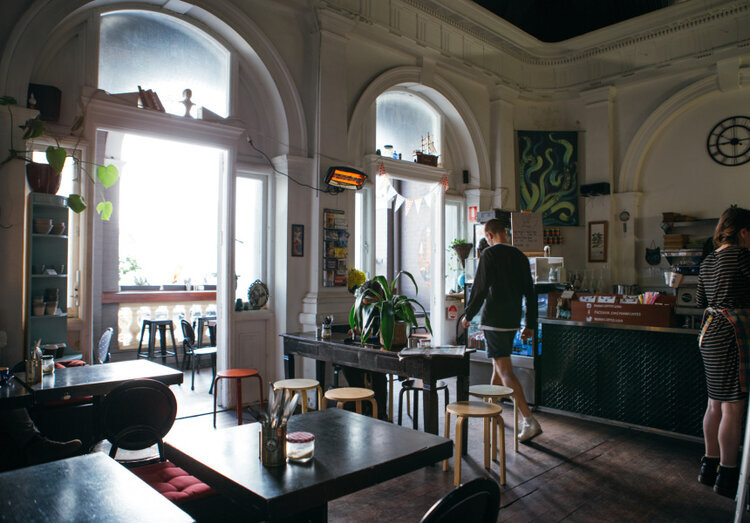
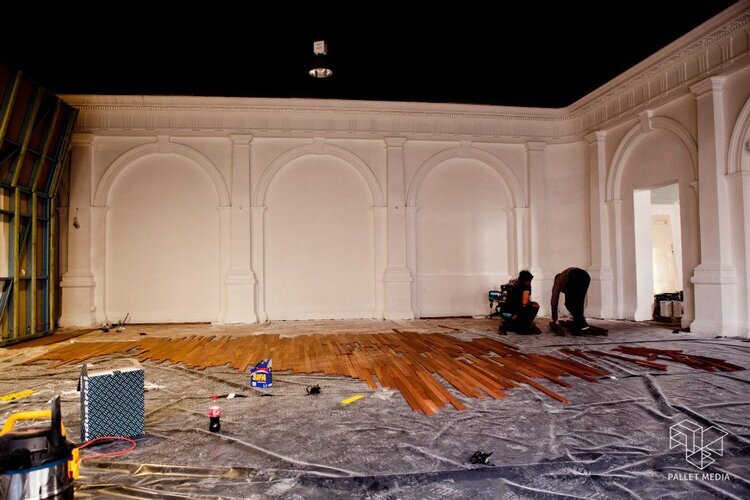
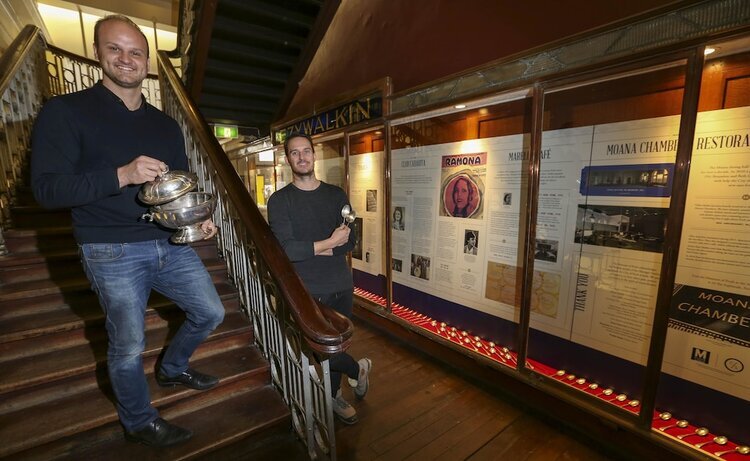
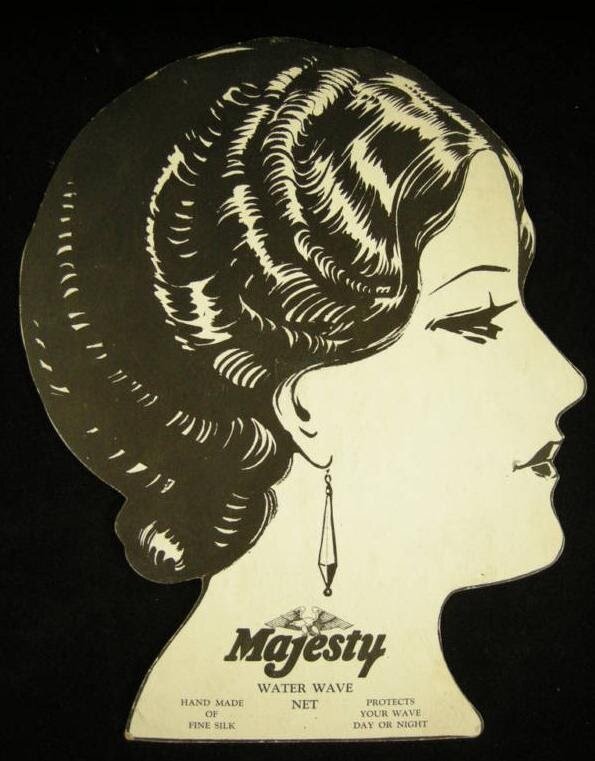
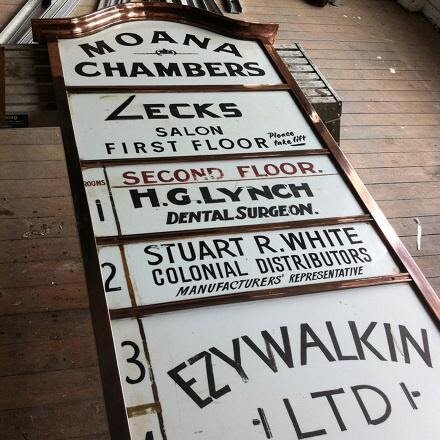


Moana Chambers
Architect’s Plans
Moana Chambers was built for Daniel Connor and his son-in-law Timothy Quinlan. The three-storey building included offices, restaurant, dining rooms, cafe and roof garden and was built to serve the affluent members of the Western Australian community, including business leaders and politicians. The building was described as the ‘finest example of Federation Free Classical Style’ in the Commonwealth.
The building was opened by Colonial Treasurer Frank Wilson on 9 March 1908, where at the gala occasion, Wilson suggested the four underground, luxurious, private dining rooms be named after four Australian Governors.
The name Moana, recorded on other buildings in the area before 1908, may have been a reference to a Polynesian word meaning ‘ocean’ or the Royal Mail Steamer Moana, which travelled the London–Colombo–Australia (East Coast) route between 1906 and 1909.
Image of RMS Moana
Plan of work above Awning 1961, Plan Courtesy of City of Perth
Richard Joseph Dennehy (1854-1939) was the architect responsible for most of the work on the Moana Chambers Building.
Dennehy was born in Cork, Ireland and arrived in Melbourne with his parents in 1855. He practiced as an architect in Victoria and NSW until 1896 when he relocated to Perth to take advantage of the gold boom. Locally, as one of the few Catholic architects in Western Australia, he worked on the Home of the Good Shepherd, Leederville, the Church of the Sacred Heart, Highgate, and the St. John of God Hospital in Subiaco as well as the Grand Theatre, Murray Street, Perth and the Tattersall's Club in Barrack Street, Perth.
Simon B Alexander, one of Perth’s most prominent builders, was awarded the contract to build Moana Chambers for £10,000, with furnishings for £4,000.
B. Makutz of William Street, Perth, provided all ironwork for the building and was responsible for fabricating the magnificent staircase, the scrolled bannister rail and the lattice girder.
Messrs Robertson and Moffat of Melbourne designed and supplied all internal fittings and furniture, using local and imported materials.
“The window fittings, counters, showcases and wall decorations on the ground floor were specially designed by the firm's artist, and are carried out in Huon pine, relieved with walnut mouldings, the whole polished and finished in the very best style, and mounted with mirror glass. The floor covering is inlaid linoleum of oak parquet pattern, which lends itself excellently to the handsome solid oak stairs, specially made by the firm. The floor is covered with a magnificent carpet of a rich colouring, which sets off to great advantage the handsome furniture, consisting of specially-designed tables, chairs, and settees, all of which we must specially mention have been constructed of our native Jarrah."
Image from biography of RJ Dennehy, Cyclopedia of Western Australia, Bartletto, Perth, page 632
Plan of alterations to Moana Chambers 1957, Plan Courtesy of City of Perth
MOANA CAFÉ – the First Proprietors
DEMETRIUS ANGELS 1908–1914
Demetrius Angels became the first proprietor of the Moana Cafe in March 1908 and commenced a dubious lineage of licensing and employment breaches whilst providing fine dining and entertainment to Perth’s elite.
Angels had operated Dining Rooms and an Oyster Saloon in an existing building on the site from 1901 and the Strand Cafe (1904) also in Hay Street. Although unsuccessful in early attempts to obtain a Colonial Wine Licence, Angels’ ambitions were not thwarted and he described the Moana Cafe & Dining Rooms as “the largest and best appointed café in Australia; banquets, suppers, wedding parties and ‘at homes’ provided for; private dinners, oyster suppers, pastry-cooks, fruiterers, confectioners, & caterers; wedding and birthdays cakes a speciality; ladies afternoon teas.”
Moana’s reputation as the ‘swaggerest restaurant in the metropolis’ was not impeded by scandal. In 1910 a pantry man, Nicholas Consoukas of Moana Cafe, was charged with throwing a knife at kitchen maid Eva Smith and cutting her wrist. Angels was also incorrectly identified as a suicide victim found in Kings Park and the story went to print before the true identity of the victim was known due to the striking resemblance between the two men.
“This Angel, who seems to have a mighty poor chance of ever donning a halo, makes a practice of employing his helps at the lowest possible rate of wages.”
By 1911 the exploitative work practices of Angels were infamous as was his opposition to all Unions. Angels, along with other local proprietors, was involved in a dispute heard in the Arbitration Court, relating to the wages and conditions of professional musicians, which had been filed by the Metropolitan Musicians’ Union of Workers WA. In July 1912, he faced defamation charges after firing an employee, Nicholas Stamboulis, accusing him of being a ‘murderer’. Evidence was given by the Hotel and Restaurant Employees Union, that Stamboulis and two others were really fired because Angels discovered they were members of the Union.
Despite scandal and breaches of health regulations the Moana Cafe continued to be patronised by Perth’s ‘best society’. Organisations like the Young Australia League hosted an American boys tour in August 1909 with a formal reception at the Moana Cafe.
Moana Dining Room, (north side) c.1930s Photo: Webb & Webb, Courtesy Nick Verevis
Moana Dining Room, (south side) c.1930s Photo: Webb & Webb, Courtesy Nick Verevis
Caricature of Saul Epstein by Gordon Clifton, Call, 21 July 1922
SAUL EPSTEIN 1914 –1937
“Everyone Who’s Anyone Goes to Moana Cafe!” Saul Epstein
Saul Epstein, a proud Jewish man of Polish descent became the second colourful proprietor of the Moana cafe. He migrated to Kalgoorlie in 1900 and moved to Perth, taking leasehold of Moana Chambers in March 1914, and with his customary cigar, became a landmark presiding over Perth’s nightlife.
Epstein was often in trouble with the law. He was charged with the Illegal sale of alcohol after being caught in a midnight raid with hundreds of bottles of German Lager and in March 1916 he pleaded guilty to selling alcohol outside of trading hours and his Liquor Licence was suspended. In June he was again found guilty of possession of liquor without a licence.
Despite his application being opposed by Police due to his two previous convictions, Epstein was supported by powerful patrons, and his Liquor License application was granted unopposed in December 1916.
Epstein used brazen stunts to maximise advertising. In December 1916 he encouraged racing car driver Charles Lewis, who had just smashed the speed record from Albany to Armadale, to leave his racer outside the cafe, where a big crowd gathered, in the busiest time of day, much to the annoyance of police who charged Lewis.
‘THE MOANA FOLLIES
Perth got a glimpse of a new form of entertainment last night when Miss Irene Bingham introduced her Moana Follies and cabaret at the Moana. The entertainment is on the latest American cabaret lines and in addition to an attractive orchestra and novelties included are some dainty vaudeville offerings and six clever dancing girls under the direction of Miss Bingham.’
Mirror, Saturday 29 May 1926, page 3
GREEK CONNECTIONS
On 27 October 1916, the day before a contentious national referendum on conscription, a pro-conscription rally was held in Perth, addressed by the Colonial Secretary, Hal Colebatch. Colebatch, who was pro-conscription, stressed the importance of the war and conscription for keeping Australia ‘white’. Anti-Greek sentiment was stirred up among Australian soldiers and Moana Cafe was one of several cafes attacked by a large mob of Australian soldiers in uniform.
The front plate-glass windows were smashed, chocolates from the window display were stolen and customers in the cafe ran out without paying.
‘Moana Cafe Vandalised and Looted
The scene became one of indescribable excitement. All the efforts of the police and soldiers to prevent wanton destruction of property were unavailing until a light horse picket, which had been sent for by the police arrived from Claremont and charged the mob. The picket restored order and arrested close on 30 soldiers’.
Rioting in Perth, Norseman Times, Tuesday 31 October 1916, page 3.
The Australian Naval and Military Expeditionary Force (AN&MEF;) before departing to fight the Germans in New Guinea. Courtesy of Australian War Memorial A03272
The attack on local businesses by soldiers was one of many throughout 1915 and 1916. The attacks were directed at businesses that soldiers believed to be owned by people disloyal to Australia, especially Greek immigrants assumed to be loyal to Germany. This was because King Constantine, whose wife Sophia was the sister of Kaiser Wilhelm, tried to keep Greece neutral during the war, despite the urgings of his Prime Minister, Eleutherios Venizelos, to join the Allies.
The crowd apparently misjudged the nationality of Moana Cafe proprietor Saul Epstein, who had in fact migrated from Russian Poland. Shopkeepers who were victims of the 1916 riots were never compensated for damage to their shops.
Epstein survived the riots and after refurbishment in 1924, renamed Moana Café to the Moana Tea and Supper Rooms.
Photo: Lafayette Studios, 1931. Courtesy Nick Verevis
Wedding
In 1917 John Curtin (Prime Minister of Australia from 1941 to 1945) was married to Elsie Needham. They came to the Moana Dining Rooms for a quiet wedding lunch after a civil ceremony. Curtin was openly anti-conscription.
Savas Leminos was proprietor of the Moana Tearooms briefly in 1930. In December of that year he was charged under the Liquor Licensing Act for selling chocolates containing alcoholic liqueurs. The case was dismissed when the chocolates were not deemed to be a beverage.
Moana Dining Room, 1931–39
From 1931 to 1939 Saul Epstein leased the Moana Cafe to Peter (Emanuel Pantazi) Auguste, who had immigrated to Perth from Castellorizo, Greece.
Auguste’s daughter Marcel and her husband George Verevis were given a wedding reception in the cafe in January 1931 and managed the cafe until 1939 when George (also the chef) was called up for war service and the lease was relinquished to Epstein. The three Verevis children Kathleen, Nick and Michael were baptised in the cafe and grew up there. Marcel’s sister Chrisanthi Auguste (Chrissie) also worked in front-of-house reception and played the piano. During this time the cafe was an important place for the Greek community and many weddings were held there.
Tables and chairs were varnished black and the room decorations were white and black to match a ‘Rudolph Valentino’ theme. The popular fan-shaped menus showed a woman with a headscarf and also served as fans, as the building had no air conditioning.
Wedding photo 31 January 1931. Helen Baster (left), Panteriz Auguste, George Pampakis, George Verevis (seated groom), Marcel Verevis (née Auguste), Manuel Auguste, Chrissie Kailis (née Auguste), Mary Soufoulis (child).
EZYWALKIN SHOES 1923- 1955
In 1923 the Moana Building was refurbished and transformed.
The basement was occupied by Zeck's ladies and children's hair specialists. The ground floor Cafe was redesigned and moved to the first floor to became the Moana Tearooms. The roof garden was rebuilt to provide second floor offices.
The whole of the ground floor was occupied by Ezywalkin’s Ltd. who made elaborate changes to the shopfront windows. Their colourful display dominated the street until 1955.
Ezywalkin Ltd was established in 1899 by Frederick Gaze and Walter David Cookes, at Boulder. They started with a small factory that aimed to manufacture a cheaper class of shoe for ordinary people, at a time when the Australian market was dominated by imported expensive English and American made shoes.
The business was immediately successful and in a few years there was hardly a town in Western Australia that did not boast of an Ezywalkin Store. A Melbourne factory was established in 1910 and the first store opened there in 1912.
Originally Ezywalkin operated from the corner of William and Hay Streets in Perth and this became known as ‘Ezywalkin corner’. However, the chief place of business between 1923 and the 1955 was the Moana Building with its colourful frontage onto Hay Street.
‘BOLD WINDOW SCHEME.
The windows consist of arcade, semi-island windows and an island showcase, the central floor of which will be revolved by a motor power. The windows are to be lined with polished swamp banksia studs, bevelled glass doors and leadlight panels. The main entrance door promises to be an artistic triumph, the construction being polished banksia, bevelled glass panels, carrying an embossed monogram. The interior will be in keeping with the artistic design of the facade. Ladies', gent's, and children's wares will be departmentalised, the interior of each being installed with special fitting chairs, unique showcases, and lighting effects.’
Call, Friday 27 April 1923, page 2
Dunlop shoes display in Ezywalkin shop window c 1951Photo courtesy State Library of Western Australia, 235,129PD
Ezywalkin Shopfront 1929, courtesy SLWA 100562PD
When Gaze died in 1932, the firm owned forty shops and operated four factories: a ‘slipper’ factory, a ‘children’s shoes’ factory; and two factories producing men’s and women’s shoes and boots. The firm became the largest manufacturers and distributors of boots and shoes in Australasia. Their original slogan of ‘Fair Wear or a Free Pair’ continued for thirty years.
In 1937 a Christmas treat was organised by the staff of Ezywalkin for fifty children from the Salvation Army Children’s Welfare League at Moana. Each child received plum pudding, fruit, lollies and new sandshoes.
The firm continued until Coles entered the footwear business by purchasing Ezywalkin in 1981 and the business was sold to the American Payless Shoe Company in 1988.
The street frontage of Moana Chambers showing Ezywalkin Shoes and Marelle Cafe on the second floor c. 1950 Photo courtesy State Library of Western Australia, 099569PD
Photo by Beth George
Moana Chambers 1923 - 1940s: Multicultural Tenants
Through the 1920s up until the 1940s the multicultural tenants in Moana Chambers included people of German, Greek or Jewish heritage:
ZECK’S BEAUTY SALON 1923–87
Established in 1902 Zeck’s Hairdressing was originally located at 78 Barrack Street. Charles Zeck relocated in June 1923 and re-opened as Zeck’s ‘toilet saloon’ downstairs in Moana Chambers.
The beauty salon was touted as being the largest and most up-to-date in WA and specialised in ladies’ hairdressing: Marcel waving, water waving, shingling, bobbing and scalp massage. Zeck’s had a separate saloon for children’s hairdressing and hired out carnival costumes, imitation jewellery, wigs, beards, stock moustaches, beauty spots, masks and theatrical make-up.
Charles Zeck immigrated to Australia with his Swedish wife, Eliza. Zeck had experience as a hairdresser in Europe and he often travelled to the Eastern States to discuss his profession with other experts. After returning from one trip around the world he determined ‘short hair for women would remain fashionable for years to come.’
They had three children, Charles Jr. (born 1905), Walter, and Lucy. From 1936 until December 1939 Charles Jr (one of the directors of the Perth YMCA) and his father ran Zeck’s together. Charles Jr took over the business and in 1942 Charles Zeck Snr. passed away suddenly, at 62 years old.
Charles Zeck Jr served with the army in 1942 and upon returning from one of his deployments overseas, filed for divorce from his wife Phyllis, citing adultery with Naval Commander Joseph Thew. His divorce was never finalised because in 1943, Charles Jr, deployed to New Guinea as a Lieutenant with the 2/43rd Australian Infantry Battalion, was killed in action.
In 1947 the YMCA held a memorial service for Lt Zeck. In his will Zeck left the hairdressing salon to Mrs AM Hunt, a former employee. Following this transfer of the family business, Charles Zeck Jr’s younger brother, Walter, opened his own salon at the Gledden Building and ceased to be associated with the original Zeck’s.
Alterations to Zeck’s Beauty Salon, which had moved to the first floor, were made in 1987. The exact date of closure is unknown.
RICHARD SPANNEY, ARCHITECT 1928-1932
Richard Spanney (born Rudolph Richard Spangenberg (1884–1948) came to WA in 1906 and trained with architects Oldham and Cox in 1919. He also studied architecture in the USA and travelled extensively before returning to WA in 1923. Spanney was a proud owner of the new American Chrysler ‘sixty-two roadster’ car and in 1928 was involved in a series of driving offences, including speeding. In 1928 he also moved into rooms 4 and 5 of Moana Chambers, where he worked until 1932.
A talented architect, he designed St John’s Lutheran Church in Aberdeen Street, the New Church in Adelaide Terrace (both built of rough-hewn laterite stone from the Darling Ranges) and the Greek Orthodox Church in Parker Street. Spanney also designed homes for many prominent Perth families, including Walter Zeck.
RICHARD SPANNEY
ADOLPHUS TERELINK, ESTATE AGENT 1924 -1926
A. TERELINCK. Moana Chambers, 618 Hay-st. WANTED. Gentlewoman, with business ability and about £150 capital to join another in an established business, showing good profits...
The West Australian, Tuesday 27 November 1923, page 1.
SILVERMAN AND SONS 1923 - 1937
In July 1935 Charles (Lazarus) Silverman (44 years old), of Silverman and Sons Tailors, at Moana Chambers was one of three men charged with the wilful murder of Edgar Arthur Whitfleld, a caretaker murdered at Caris Bros jewellery shop on February 5, when diamond rings valued at over £5000, were stolen from the shop.
Sensational evidence was heard in the Criminal Court. The three were acquitted of murder but were re-arrested immediately and charged with theft and receiving. Charles Silverman was sentenced to six years in prison, where he worked in the tailor’s shop and was released from Fremantle Gaol in 1939.
J SALTER, SHOWCARD WRITER, 1926
Photo: Private J Salter, 11th Battalion, Wounded, Sunday Times, 25 July 1915, p 1.
Carmel Somers
Sister Couper’s, Chiropodists, 1937
Miss Carmel Somers – one of Western Australia's leading chiropodists and late of Sister Couper’s, Moana Chambers… is now in daily attendance at Boans footwear department.
OTHER TENANTS
Boxall and Lynch, Dentists, 1925 -1935
VM Blick, Optician
A Hertz, Watchmaker
Mrs KG Mathias, Employment Bureau
Max Golding, Tailor
Sol Shilkin, Wool Merchant 1929 - 1936
La Vogue Lingerie, Agents, 1933
Mrs. Reading’s Employment Bureau, 1933
Silk Fashions, Lingerie Manufacturers, 1934
Coventry Textile Industries, 1935-1940
Pierce Lorrigan, Accountant, 1934
Walter Brooke, Commercial Artist, 1934
Gordon Williams, Photographer, 1936
Miss Phyl Blight, Dressmaker, 1938
F Kalman, Tailor, 1938
Alex S Lambert, Jeweller, 1939
G George, Tailor, 1941
Max Golding, Tailor, 1943
Koci Zorgji Roshani (Albanian), Tailor, 1945
Club Cabarita WWll
Club Cabarita was a glamorous dinner and dance venue, which operated at the Moana Chambers Building throughout the Second World War.
It opened for business in July 1942 under the management of Mrs Mary Ellen Dorothea Veronica Harrington (known as Molly Wagner) and Mrs Jessie Gladys Levien.
Molly Wagner (1911-1992), a talented pianist, gained her music teacher qualifications while still a schoolgirl. Her sister Pat taught singing. The two sisters were close, marrying best friends; Pat to Corporal Bruce Weir, in May 1941, and Molly to Signaller Edgar C (Ted) Harrington in January 1942.
Molly Wagner (1911-1992), a talented pianist, gained her music teacher qualifications while still a schoolgirl. Her sister Pat taught singing. The two sisters were close, marrying best friends; Pat to Corporal Bruce Weir, in May 1941, and Molly to Signaller Edgar C (Ted) Harrington in January 1942.
Molly formed a ten-piece orchestra in 1933, one of the first in the State to be established and run by a woman. For the next seven years the popular Molly Wagner’s Orchestra played regular engagements at high-class balls and concerts, around Perth and in country areas.
In November 1940 the orchestra played the summer season of the Lido Cabaret in Cottesloe, which provided supper and dancing from 10.30pm until 3am on Saturdays. They continued playing at the Lido until March 1942, when the orchestra slowly disbanded as the musicians, and her husband, joined the fighting services and were dispatched overseas.
Perhaps it was at the Lido that Wagner saw the potential of opening a similar supper and dancing club in Perth. In 1942, she joined forces with Jessie Levien, Secretary of the Karrakatta Club to organise the first ‘Club Cabarita’ at the Karrakatta Club hall on St. George's Terrace. It was organised on the same lines as similar clubs in the Eastern States, which provided entertainment for the Allied forces. The hall was arranged cabaret fashion with tables and Union Jacks and the American flags lining the walls.
Club Cabarita moved to Moana Chambers, where the Molly Wagner Band played for dinner dances every night except Mondays from 7 to 8.30 pm. Her sister sometimes accompanied her and Molly’s quartet also included Isobel Reith, a soprano singer, Faith Court, and Melva Brown.
The popular Club was often on the wrong side of the law. It did not have a liquor licence and Wagner and Levien made regular appearances in court, charged with allowing patrons to consume alcohol they had smuggled in. On New Year’s Eve 1943 the Liquor Branch raided the club and three girls were caught with jugs containing whisky, gin and sherry. It was difficult to stop the smuggling of alcohol into the club and in October 1943 the Liquor Branch caught a naval officer carrying two bottles hidden in brown paper into the club, despite being warned not to by doorkeeper Nora Hassell. In December 1943 both Club Cabarita, and the Lido in Cottesloe were raided.
Pat (left) and Molly Wagner, on Molly’s wedding day, The Daily News, 1 January 1942.
Daily News 1 January 1942, p11
Many ‘incidents’ recorded in the popular press, contributed to the ’shady’ reputation of the Cabarita. The Mirror social writer regularly hinted at romances that flared at the Club between local women and American servicemen and the glamorous appearance of the women there including Molly and Pat Wagner.
‘Went to the Cabarita Saturday night. Crowded as usual, of course, but nobody seems to mind.’
The Mirror, 18 November 1944
The Cabarita also had difficulties with employment laws for women. Written to regulate the restaurant industry, the laws ruled women were not allowed to work more than three consecutive late nights in one week. Charged with breaking this law in 1945 Club Cabarita argued it had a satisfactory arrangement between employers and employees. The magistrate agreed that it would be difficult, given the nature of the business, which only operated at night, to comply with the law. He convicted the proprietors but suggested an amendment be made, and this consequently led to changes in employment laws.
‘Taxi Dancers’ Not for WA
Although Sydney nightclubs had introduced taxi dancers and were charging as much as £4/4/- a night, Perth dancers would not rush such a scheme. This was the opinion of Cabarita Club manageress Molly Wagner. Miss Wagner said that Perth was different from the Eastern States in that the population was smaller and ‘Seldom does a girl go to a nightclub here unescorted. Most Perth nightclub parties are planned and I think Perth girls would be rather shocked at the idea of dancing with a hired man.’
Daily News, Saturday 6 July 1946, page 10.
Club Cabarita also made their venue available for organisations to fundraise for war causes such as the Emergency Housekeeper Scheme, which supported women working on farms alone, while men were away at war (July 1943) and fashion shows in aid of the War Veterans' Appeals (September 1945). In 1946 Club Cabarita partnered with radio station 6KY, holding a Musical Quiz at every Friday night cabaret, led by Betty Fry and the Cabarita Quartette.
Betty Smith, a journalist and daughter of WA Newspaper owner C.P. Smith often visited the Cabarita Club, where she danced the jitterbug alongside American servicemen. This photo shows her with husband Karl Knapp (an optometrist manpowered to stay in Perth during WWII) c. 1946.
Molly Wagner went on to perform as a solo pianist in the late 1940s. She and Ted Harrington lived in Mandurah in the 1950s, where they formed a social club called ‘the Over Forties’. Edward Harrington died in 1991 and Molly was buried alongside her parents at Karrakatta Cemetery in 1992.
Photo courtesy Digby Knapp.
1950s – 1990s
In March 1947 management of Club Cabarita switched to vivacious Perth actress and producer Irene Elizabeth McMorrow (known as Renee Esler). Freshly separated from her husband, dancer Gerald McMorrow, Esler threw herself into the job and offered morning and afternoon teas, lunch, catering for weddings and cabarets and dinner/dances on Friday and Saturday nights.
In May 1948 Renee Esler became sick and sold Club Cabarita to Vera Bruce of Melbourne, a dancer who had ‘never once being defeated in the national dancing championships’.
The club was closed for renovations and then opened under the name Marelle, a French word for ‘hopscotch’. Mrs Bruce specialised in wedding and birthday receptions and encouraged a more conservative atmosphere with ‘Magicians’ and ‘Scandinavian’ nights.
‘Perth Central Fire Brigade answered a call at 4.30 this morning to the Marelle Cafe, in Hay St. There a fire in a stack of firewood alongside a stove was extinguished with buckets of water before any damage was done.’
Mirror, Saturday 5 September 1953
Menu for the annual meeting of the WA Motion Picture Projectionists at the Cabarita nightclub, 9 July 1947. Photo courtesy of Museum of Performing Arts, His Majesty’s Theatre
Moanna Tearooms in the building next to the Moana Chambers in the 1950s SLWA 099570PD BA 5558/188
Every Monday night during 1954, the Marelle hosted a ‘Teen and Twenty Nite club’ for teenagers. Sometime during the 1950s the Marelle finally closed its doors.
In 1941 the decision had been made to redesign 618 Hay Street, replacing the street level tearooms with independent store frontages. Moana Tearooms moved to the ground floor of the building next door.
Stella Stewart’s mother Molly (Alice Wise) worked in the Tea Rooms during World War ll. She travelled down on a bus from Kalamunda to work as a ’slushie’, washing dishes in the kitchen.
Brash’s Music Store 1992
Brash's Music Store, founded in Melbourne in 1862 by German immigrant Marcus Brasch became the new ground floor tenant. By the 1990s the family music business sold Hi Fi stereos, video cassette recorders, microwaves and televisions.
Sanity Music Store 1998
In June 1998, Sanity acquired 27 outlets from the Brash’s music chain on its demise, relaunching all of them as Sanity music stores.
Valley Girl 2005
Valley Girl, clothing outlet became the new ground floor tenant.
MOANA CHAMBERS RESTORATION PROJECT
Moana Ballroom Pre-renovation 2011, Photograph Pallet Media
The Moana dining hall lay empty and abandoned for over a decade.
In 2010 a group called Post-Architecture (Nic Brunsdon and Beth George) investigated the site with help the City of Perth and designed new uses for the space.
‘Pallet Media has been heavily involved in the construction/renovation process of Moana Chambers. We have cleaned, sanded, scraped, painted, dusted, mopped, bashed, drilled, sawed and hammered what was once a disused and derelict space into a stunning piece of architecture that showcases everything that is right about Perth and its creative community!’
After extensive restoration during 2011, Spacemarket opened offices in 2012 on the first floor. They also designed a contemporary gallery space in a purpose built, wooden cube and a café, which utilised the outdoor space of the balcony.
Artists Kate Mullen and Dale Buckley, instrumental in the restoration works, become the first tenants taking the lease on the gallery pod: the Moana Gallery and Project Space.
2012 also saw a new ground floor fit out and shop front for Moana Chambers tenant, Valley Girl.
In 2014 Post-Architecture was honoured for their work in the WA Architecture Awards. Moana Chambers was shortlisted for the Interior award and Commended for a Heritage award.
Acknowledgements:
Paola Anselmi
Nic Brunsdon and Beth George (Post-Architecture)
Connor Quinlan Owners, Moana Chambers
Prue Griffith
Ivan King, Curator, Museum of Performing Arts, His Majesty’s Theatre
Digby Knapp, Shane Launders, Greg Shea,
Edward Cooper, A Merry Go Round of Perth, Curtin University 2013
Janet McCrumb and Tammy Rae Schaper, YAL Museum
Nick, Michael and Kathleen Verevis
Project Supervisor: Jo Darbyshire
Researchers: Ken Stafford, Mar Bucknell, Ghielmie Daniels, Dan Seymour, Dianne Chapelton, Damian Bateman, Hendrix Kaukau, James Gregory, Ben Reda


